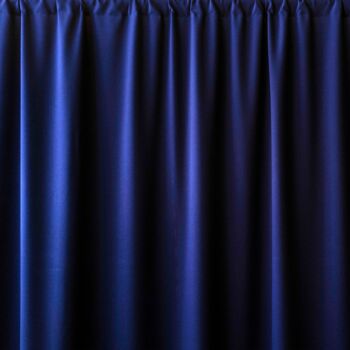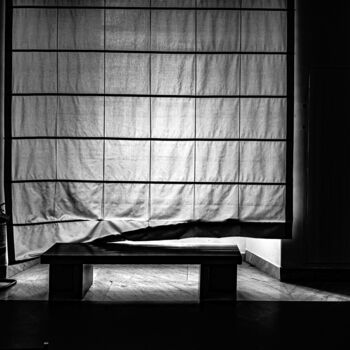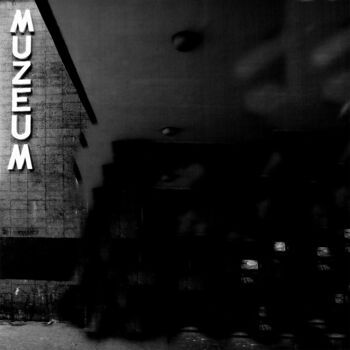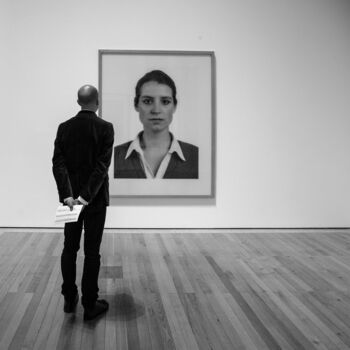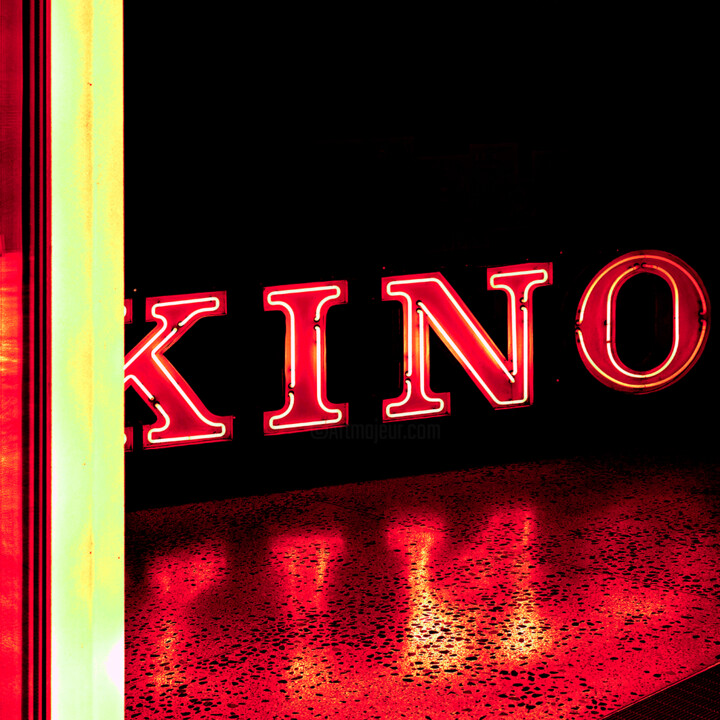


Let us know if you would like to see more photos of this artwork!
- Back of the work / Side of the work
- Details / Signature / Artwork's surface or texture
- Artwork in situation, Other...
CINEMA 19:43 # 16. FROM THE SERIES: CINEMA (2019) Photography by Marta Lesniakowska
More info
- Packaging (Box or cardboard packaging) All artworks are shipped with a premium carrier, carefully protected and insured.
- Tracking Order tracking until the parcel is delivered to the buyer. A tracking number will be provided so that you can follow the parcel in real-time.
- Delay Worldwide delivery in 3 to 7 days (Estimate)
- Customs not included The price does not include customs fees. Most countries have no import tax for original artworks, but you may have to pay the reduced VAT. Customs fees (if any) are to be calculated on arrival by the customs office and will be billed separately by the carrier.
More info
- Trackable Online Certificate of Authenticity Authenticity Certificates can be verified online at any moment by scanning the artwork code.
- Artist Value Certification Experts study the work and career of an artist then establish an independent and reliable average price value. The average price value situates the artist on a price range for a given period. The experts may also be asked to establish a more precise estimate for a particular work.
More info
100% secure payment with SSL certificate + 3D Secure.
More info
-
Limited Edition (#1/5)
Photography,
Digital Photography
/
Non Manipulated Photography
/
Digital Print
on Paper
- Dimensions Height 15.8in, Width 15.8in
- Artwork's condition The artwork is in perfect condition
- Framing This artwork is not framed
- Categories Photographs under $5,000 Minimalism City
Pole obrazowe tej minimalistycznej fotografii z neonem nieczynnego kina zbudowane zostało ze słowa, geometrii, diagonali i znanej ze stylu film noire gry światło-ciemność. Z drugiej strony agresywny kolor słowa-obrazu jako ekwiwalentu kina jest powiązane z analogową estetyką fotografii barwnej lat sześćdziesiątych-osiemdziesiątych XX wieku i sztuki artystów popkulturowych, którzy stosowali słowa jako narzędzia estetyczne, czasem przekształcane w abstrakcyjne formy bez dosłownego znaczenia. Moja fotografia dialoguje więc z fotografią Williama Egglestona i z obrazami-słowami Eda Ruschy, prekursora kultury słów w ruchu, „nieustraszonego badacza języka i obrazu”. Ten anachronizm ma w mojej fotografii znaczenie. Pulsująca czerwień neonu wyłania się z obramowanej żółtą ramą czarnej pustki i powiela w zmętnionym odbiciu posadzki, determinując, jak w teście Rorschacha, psychofizjologię percepcji. Ewokuje poczucie spleenu, melancholii i widmowości przywołującej anachronicznie etos modernistycznego kina z jego atmosferą ciemnej sali kinowej, interpretowanej jako prefiguracja platońskiej jaskini. Jej obrazowym ekwiwalentem jest „New York Movie” Edwarda Hoppera (1939) z postacią samotnej bileterki w niemal pustej żółto-czerwonej sali kinowej. Moja fotografia jest metamodernistyczną grą z melancholijną poetyką hopperowskiego spojrzenia i kierując wzrok widza poza obraz odnosi się do jego istoty: problemu ramy jako parergonu, marginesu koniecznego, by ustanowiona została widzialność przedmiotu, jak pisze Mieke Bal za Derridą. Rama, zauważa z kolei Gilles Deleuze, dokonuje deterytorializacji obrazu, czyniąc go fragmentem sytuacji niedookreślonej, z której został wycięty stając się „drugim tekstem”, niezależnym od tego, co widzimy. W dekadrażu więc, od tego co widoczne, bardziej znaczące jest to, co znajduje się poza ramą, ukryte w mroku, widmowe, a co w perspektywie psychoanalitycznej jest wizualnym kluczem do semantyki „wyobrażonego znaczącego” (Christian Metz). Moja fotografia dotyczy więc samych podstaw kina i obrazu. Odsłania i zarazem skrywa swoją wielowarstwowość i nieoczywistość, transmediując na różnych poziomach równocześnie z kulturową tradycją kina i z obrazem Hoppera, w którym reżyser Sam Mendes dostrzegł, jak światło i cień „tworzą coś więcej niż tylko nastrój; ukrywają lub ujawniają myśli i emocje. […] Zaczynasz wyobrażać sobie, co znajduje się po obu stronach kadru, […] co znajduje się poza kamerą". Oraz, last but not least, oniryczną atmosferą ostatniego seansu filmowego w dystopijnym wnętrzu kina w filmie „Goodbye, Dragon Inn” z 2003 roku Tsai Ming-lianga.
Te złożone relacje są tematem mojego fotograficznego sequela zarówno obrazu Hoppera, jak filmu Tsai Ming-lianga. Kino, zredukowane do neonowego słowa jako jego (kina) obrazu ekwiwalentnego, zostaje jednak przeniesione w dzisiejszy kontekst kultury akceleracji społeczeństwa usieciowionego, gdzie daje się obserwować „paradoksalna płodność anachronizmu” (Didi-Huberman): ponowna potrzeba cielesnego doświadczania sali kinowej jako prymarnej przestrzeni w historii kina. Moja fotografia to zatem metamodernistyczna transmediacja z modernistyczną tradycją, poprowadzona po to, by pytać, czy i jak rezonuje ona w dzisiejszej kulturze XXI wieku. (ml)
Fotografia wyróżniona przez kuratora Artmajeur w dziale Ekskluzywne galerie 2023: "Czerwony"
The cinema, as well as the car park, the hotel, the night bar and the shop windows are canonical figures that define the modernist city, whose vision, imagery was constructed in its own aesthetic way by modernist painting, photography and film.
The pictorial field of this minimalist photograph with the neon sign of a defunct cinema was constructed from words, geometry, diagonals and the play of light and dark known from the film noire style. On the other hand, the aggressive colour of the word-image as equivalent to the cinema is linked to the analogue aesthetic of 1960s-eighties colour photography and the art of pop culture artists who used words as aesthetic tools, sometimes transformed into abstract forms without literal meaning. My photography thus dialogues with the photography of William Eggleston and with the images-words of Ed Ruscha, a precursor of word culture in motion, a 'fearless explorer of language and image'. This anachronism is significant in my photography. The pulsating red of the neon sign emerges from the yellow-framed black void and replicates in the cloudy reflection of the floor, determining, as in a Rorschach test, the psychophysiology of perception. It evokes a sense of spleen, melancholy and spectrality recalling anachronistically the ethos of modernist cinema with its atmosphere of the dark cinema room, interpreted as a prefiguration of a Platonic cave. Its pictorial equivalent is Edward Hopper's 'New York Movie' (1939) with its figure of a lone ticket taker in an almost empty yellow and red cinema hall. My photograph is a metamodernist play with the melancholic poetics of the Hopperian gaze and, by directing the viewer's gaze beyond the image, it addresses its essence: the problem of the frame as parergon, the margin necessary for the visibility of the object to be established, as Mieke Bal writes after Derrida. The frame, Gilles Deleuze notes in turn, performs a deterritorialisation of the image, making it a fragment of the underdetermined situation from which it has been cut by becoming a 'second text', independent of what we see. In decadrage, then, what is more significant than what is visible is what is outside the frame, hidden in darkness, spectral, and which, in a psychoanalytic perspective, is the visual key to the semantics of the 'imagined signifier' (Christian Metz). My photography thus concerns the very foundations of cinema and the image. It reveals and at the same time conceals its multilayeredness and non-obviousness, transmediating on different levels simultaneously with the cultural tradition of cinema and with Hopper's painting, in which director Sam Mendes saw how light and shadow 'create more than a mood; they hide or reveal thoughts and emotions. [...] You begin to imagine what is on either side of the frame, [...] what is off-camera". And, last but not least, the dreamlike atmosphere of the final film screening in a dystopian cinema interior in Tsai Ming-liang's 2003 film “Goodbye, Dragon Inn”.
These complex relationships are the subject of my photographic sequel to both Hopper's painting and Tsai Ming-liang's film. Reduced to the neon word as its (cinema's) equivalent image, the cinema is nevertheless relocated to today's context of the accelerating culture of a networked society, where the 'paradoxical fecundity of anachronism' (Didi-Huberman) can be observed: the renewed need for the bodily experience of the cinema room as a primordial space in the history of cinema. My photography is thus a metamodern transmediation with the modernist tradition, guided to ask if and how it resonates in today's 21st century culture. (ml)
Photograph featured by curator Artmajeur in Exclusive Galleries 2023: "Red"
Collector's photography color/ digital on archival paper Hahnemühle Photo Rag Baryta 315g (semi-flash), archival paper, acid-free/ signed on the front and on the back / dated 2019/print BAT (bon a tirer) 2023/ Format 40x40 cm on a paper 50x50 cm
Related themes
KinoWilliam EgglestonEd RuschaEdward HopperFotografia Kolorowa
Marta Lesniakowska is an artist photographer but also, at the same time, historian and art critic, she does research on visual culture. This is what determines his approach to photography: a strategy of the “look that remembers”, which recalls familiar images from the history of art in order to transmit/intertextualize them. Her dialogue with them consists in asking herself if it is possible to evoke their meanings and what they are or can be today. She is fascinated by light - its role in the construction of the image, the parergon that creates the image. This is why, in street photography, she analyzes the interplay of light and dark, the relationship between sharpness and blur and the interpenetration of images as simultaneous realities. In this way, she brings out the mysterious character of the city, referring to the aesthetics of black cinema and to the master of 20th century street photography, Saul Leiter.(ml)
When she takes photographs, nothing is more or less important to her; his gaze is often governed by the principles of minimalist poets: an economy of detail, the discovery of subtexts and insinuations hidden in invisible objects and bits of everyday reality.
Marta Lesniakowska lives and works in Poland. His works are part of public collections (National Museum in Wroclaw, Museum of Bydgoszcz) and private collections (Netherlands, Denmark, Germany, Sweden, Switzerland, United States).
-
Nationality:
POLAND

- Date of birth : unknown date
- Artistic domains: Works by professional artists,
- Groups: Professional Artist Contemporary Polish Artists




